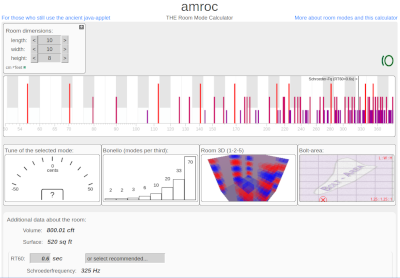When you record audio in an enclosed space, one of the effects on sound is that certain frequencies are sharply reinforced by reflections from the walls, floor, and ceiling. Which frequencies tend to "buzz" or "ring" is a matter of room dimensions and microphone placement. You can hear the resonant notes as a hollowness or peakiness: talking people sound as if they are in a barrel or musical instruments have certain notes which are unusually louder.
The degrading effect of room resomance is mitigated primarily by damping the reflections. Padding a room's surfaces with soft, sound absorbent material will attenuate reflections by a number of decibels. Thicker panels or curtains will be more effective, but even a heavy treatment will not completely remove the resonance efects, as a padded chamber is still a chamber.
For loud content, such as amplified voices or music, plan to use equalization or DSP plugins in you editor to reduce sound at the resonant frequencies. These are mostly in the low end of the audio spectrum, often between 70 Hz and 300 Hz. Large rooms resonate lower in the spectrum, while smaller smaces resonate higher. There are multiple reflection modes for sound in a chamber, so there are multiple frequencies involved. If you can notch out the bottom two or three, most of the sound degradation will be mitigated.
Use a parametric EQ to reduce narrow slices of spectrum at the resonances, so that you do not remove components of the sound you want to record.
I gave the calculator a try, and it works. After plugging in the dimensions of a test room, then setting up my laptop and microphone on a coffee table in the center of it, I made a screen recording of a session with AMROC. On loudspeaker playback, the room did indeed have peakiness as predicted. Using a parametric EQ plugin in my editor to reduce the biggest resonances did improve my audio. I reduced all of the "big red resonances" below 230 Hz by 7 dB. It didn't make much of a difference when I was close to the microphone, but oh, try it from a half meter or more away. There was still reverberation off of the hard walls, floor, and ceiling, but the sound was no longer hollow.
DSP plugins can take out the effects of room resonance. Nearly 100% of these solutions were written for high fidelity playback and are beyond the scope of room correction for creation of audio content. The main issue is that listener-oreiented DSP works with sound sources meters from the listener, with resonances nulled at the listener's position. A podcaster or voiceover artist, however, is going to speak into a microphone several centimeters away, much louder than the reflected sound, with a need to reduce sounds reflected back at a few fairly low frequencies. I will admit, though, how Camilla DSP is a fabulous software package for better playback on loudspeakers.
In conclusion, know that room resonance is a factor whenever you are recording playing back sound in an enclosed space. As one making podcasts or voiceovers, your best solution is to speak closely to the microphone and apply sound damping panels to the walls and ceiling, and carpet the floor. When you are in a situation of recording in a hard-surfaced space, consider EQ to reduce sound at the resonant frequencies, especially for those notes below about 300 Hz, which can cause audio to seem somewhat hollow.
© 2020 - 2026 Catbirdlinux.com, All Rights Reserved. Written and curated by WebDev Philip C. Contact, Privacy Policy and Disclosure, XML Sitemap.

